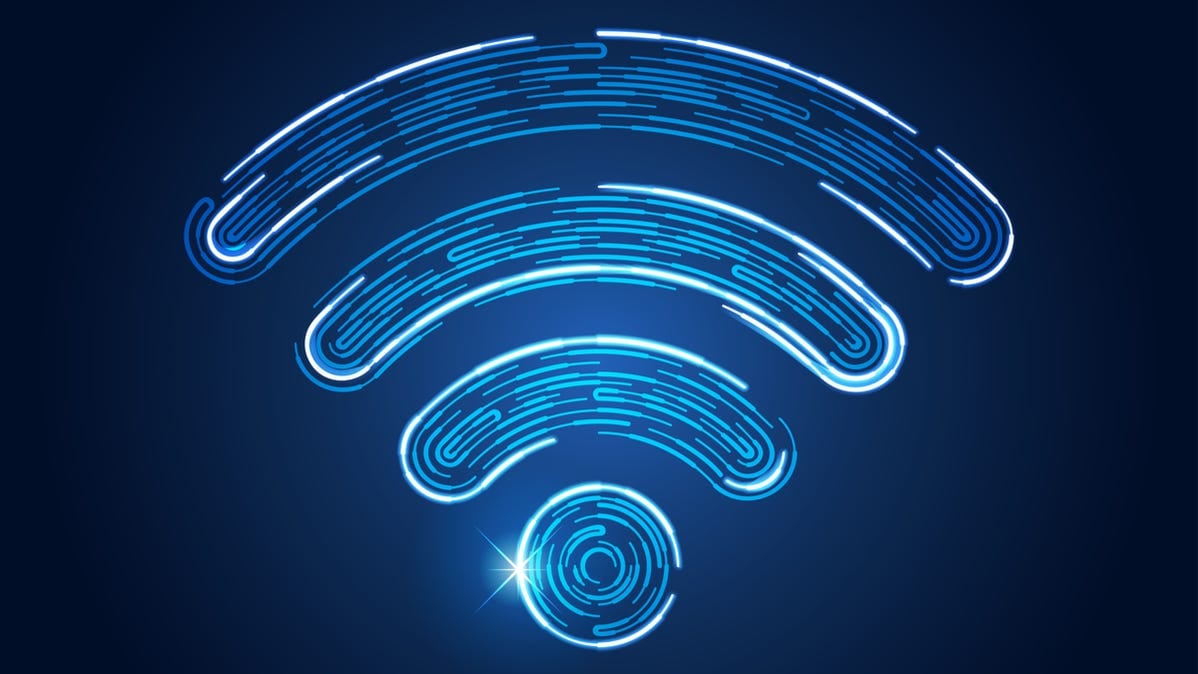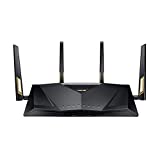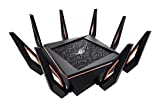
Although Wi-Fi 6E still feels bleeding edge at the start of 2023, Wi-Fi 7 is just around the corner, and sporting speeds that might make transfer speeds might make Ethernet cables obsolete. Let’s take a look at the proposed spec and what it promises.
What Is Wi-Fi 7? How Fast Is It?
Wi-Fi 7 is a new specification for Wi-Fi devices currently in the works. It’s based on the draft 802.11be standard, published in May 2021, that has not yet been finalized or approved by the FCC.
The most show-stopping feature of Wi-Fi 7 is that it might make wired Ethernet connections obsolete for a certain class of both home users and professionals—the first live demonstration of the standard in early 2022 showcased some mind-blowing speeds.
Wi-Fi 7 can theoretically support bandwidth up to 46 gigabits per second (Gbps) per access point, which is just shy of five times as fast as the maximum 9.6 Gbps speed of Wi-Fi 6 (also known as 802.11ax). The draft authors call this “Extremely High Throughput,” or EHT.
Currently, commonly-available wired Ethernet technology maxes out at 10 Gbps (10GBASE-T), although it’s basically non-existent in consumer devices at the moment. And although higher speeds (such as Terabit Ethernet) exist in specialist settings like data centers, its arrival in the home or small business setting—if it ever happens—is likely far off.
So for current users of both Gigabit and 10 Gigabit Ethernet, Wi-Fi 7 might be able to replace the need for wired connections under optimal conditions—though purists and power users will likely continue to use hard-wired connections for the foreseeable future.
What Else Is Cool About Wi-Fi 7?
Aside from the theoretical potential of blazingly fast speeds of Wi-Fi 7, the Wi-Fi Alliance plans to include other notable improvements in the Wi-Fi standard.
Full Utilization of the 6 GHz Band
Full utilization of the new “6 GHz Band” (actually 5.925–7.125 GHz), was first supported in Wi-Fi 6E. The 6GHz band is currently only occupied by Wi-Fi applications (although that might change), and using it results in dramatically less interference than the 2.4 GHz or 5 GHz bands.
Even Lower Latency
The draft Wi-Fi 7 spec aims at “lower lateness and higher reliabilities” for time-sensitive networking (TSN), which is essential for cloud computing (and cloud gaming). It’s also a critical requirement for replacing wired Ethernet connections.
While Wi-Fi 6 already offers significant improvements over Wi-Fi 5 in the latency department, the goal of Wi-Fi 7 is to provide consistent single-digit millisecond latency for all devices across the entire network—and not just for the devices in the optimal coverage area.
Load Balancing with Multi-Link Operation
Wi-Fi 7 offers Multi-Link Operation (MLO) with load balancing and aggregation that combines multiple channels on different frequencies to deliver better performance.
This means a Wi-Fi 7 router will be able to utilize all bands and channels available dynamically to speed up connections or avoid bands with high interference. This improvement, along with the others listed here, is how Wi-Fi 7 can hit a theoretical maximum throughput three times higher than Wi-Fi 6.
Upgrades to 802.11ax
According to the draft spec, Wi-Fi 7 will offer direct enhancements of Wi-Fi 6 technologies, such as 320 MHz channel width (up from 160 MHz in Wi-Fi 6), which allows faster connections, and 4096 quadrature amplitude modulation (QAM) technology that allows more data crammed into each hertz.
Your Wi-Fi 7 Questions Answered
Talking about specs is fun, but for day-to-day use people have much more concrete questions. Let’s take a look at the most frequent questions we get about Wi-Fi 7.
Is It Backwards Compatible?
The Wi-Fi 7 draft spec spells out backward compatibility with legacy devices in the 2.4 GHz, 5 GHz, and 6 GHz bands, which means you won’t need all-new devices or hardware to connect to a Wi-Fi 7-enabled router.
Just like your Wi-Fi 5 devices work on a Wi-Fi 6 network (and, conversely, your Wi-Fi 6 devices work on a Wi-Fi 5 network), the Wi-Fi 7 standard continues the tradition of cross-generation compatibility. Naturally, however, you won’t get all the benefits of Wi-Fi 7 unless you’re using a Wi-Fi 7 device with your Wi-Fi 7 router.
Is It Significantly Better Than Wi-Fi 6 and 6E?
On paper and in laboratory tests with compatible gear, yes, Wi-Fi 7 is significantly better than previous Wi-Fi standards.
However, like with all previous Wi-Fi generations, you won’t see the full benefit of Wi-Fi 7 until you pair it with Wi-Fi 7 hardware. That said, the Wi-Fi 6 optimizations we mentioned in the previous section will help Wi-Fi 7 routers provide an even better experience to Wi-Fi 6 devices on your network.
Is Wi-Fi 7 More Secure?
Given the number of facts and figures you have to take in to compare Wi-Fi generations to each other (as well as the seemingly limitless number of routers out there) it’s easy to get confused about security standards.
The Wi-Fi standard is separate from the security standard, Wireless Protected Acess (WPA) used by modern Wi-Fi hardware. Wi-Fi 5 supports WPA2, Wi-Fi 6 and 6E support WPA3, and Wi-Fi 7 will ship with WPA3 support. (In theory, a WPA4 is on the distant horizon but as of now you’ll find little more than a passing reference in the form of “WPA4 (TBD)” sprinkled here or there in technical documents.)
In short, when you purchase a new Wi-Fi 7 router it will have the most current Wi-Fi security available and will be as secure (or more secure) than your current router depending on the age of the replaced router model.
Should I Buy a Wi-Fi 7 Router As Soon As They’re Available?
If you’re rocking an ancient Wi-Fi router, especially one struggling to meet your household’s growing demands, you’d likely be well served to snap up a Wi-Fi 7 router.
If you recently bought a nice Wi-Fi 6 or Wi-Fi 6E router, however, there’s no rush. While there are clear benefits to the Wi-Fi 7 standard even if you’re a cutting-edge sort of user that adopts new technology as soon as it comes out, it’ll be a while until you see tangible benefits from switching your home over to Wi-Fi 7 if you’re already on Wi-Fi 6 or better.
Chasing performance benchmarks is fun, but in real-world applications, you only need so much bandwidth to watch YouTube videos on your phone or sit on a Zoom call at work.
So if you have a dusty old mid-tier router you bought off the shelf at Best Buy 5+ years ago, consider upgrading. But if you’re already rocking a current and premium setup, feel free to sit it out for a spell and wait for the Wi-Fi 7 prices to drop (and more end devices to support it).
When Will Wi-Fi 7 Be Available?
With all this information in hand, there’s the final million-dollar question. When will you be able to buy a Wi-Fi 7 router?
According to a CES 2023 news release from MediaTek, Wi-Fi 7 is now production ready. Announcements from major router companies support that. In November of 2022, TP-Link announced a line of Wi-Fi 7 routers. And at CES 2023, ASUS announced two premium Wi-Fi 7 routers. The TP-Link routers are projected to be available in early 2023, with Wi-Fi 7 routers from other manufacturers trickling in throughout 2023.
In the meantime, you can already buy routers that support Wi-Fi 6 (and Wi-Fi 6E), which is still impressive compared to earlier Wi-Fi standards. We’ve written a guide covering the best routers on the market. Whichever way you choose to go, it’s clear there are exciting times ahead for wireless networking.
The Best Wi-Fi Routers of 2022

Best Wi-Fi Router Overall
Asus AX6000 (RT-AX88U)

Best Budget Router
TP-Link Archer AX3000 (AX50)

Best Cheap Router
TP-Link Archer A8

Best Gaming Router
Asus GT-AX11000 Tri-Band Router

Best Mesh Wi-Fi Router
ASUS ZenWiFi AX6600 (XT8) (2 Pack)

Best Budget Mesh Router
TP-Link Deco X20

Best Modem Router Combo
NETGEAR Nighthawk CAX80

Best VPN Router
Linksys WRT3200ACM

Beat Travel Router
TP-Link AC750

Best Wi-Fi 6E Router
